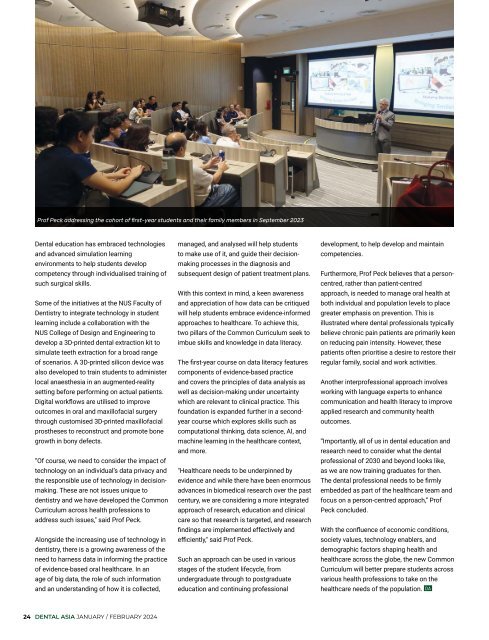Dental Asia January/February 2024
For more than two decades, Dental Asia is the premium journal in linking dental innovators and manufacturers to its rightful audience. We devote ourselves in showcasing the latest dental technology and share evidence-based clinical philosophies to serve as an educational platform to dental professionals. Our combined portfolio of print and digital media also allows us to reach a wider market and secure our position as the leading dental media in the Asia Pacific region while facilitating global interactions among our readers.
For more than two decades, Dental Asia is the premium journal in linking dental innovators and manufacturers to its rightful audience. We devote ourselves in showcasing the latest dental technology and share evidence-based clinical philosophies to serve as an educational platform to dental professionals. Our combined portfolio of print and digital media also allows us to reach a wider market and secure our position as the leading dental media in the Asia Pacific region while facilitating global interactions among our readers.
You also want an ePaper? Increase the reach of your titles
YUMPU automatically turns print PDFs into web optimized ePapers that Google loves.
Prof Peck addressing the cohort of first-year students and their family members in September 2023<br />
<strong>Dental</strong> education has embraced technologies<br />
and advanced simulation learning<br />
environments to help students develop<br />
competency through individualised training of<br />
such surgical skills.<br />
Some of the initiatives at the NUS Faculty of<br />
Dentistry to integrate technology in student<br />
learning include a collaboration with the<br />
NUS College of Design and Engineering to<br />
develop a 3D-printed dental extraction kit to<br />
simulate teeth extraction for a broad range<br />
of scenarios. A 3D-printed silicon device was<br />
also developed to train students to administer<br />
local anaesthesia in an augmented-reality<br />
setting before performing on actual patients.<br />
Digital workflows are utilised to improve<br />
outcomes in oral and maxillofacial surgery<br />
through customised 3D-printed maxillofacial<br />
prostheses to reconstruct and promote bone<br />
growth in bony defects.<br />
“Of course, we need to consider the impact of<br />
technology on an individual’s data privacy and<br />
the responsible use of technology in decisionmaking.<br />
These are not issues unique to<br />
dentistry and we have developed the Common<br />
Curriculum across health professions to<br />
address such issues," said Prof Peck.<br />
Alongside the increasing use of technology in<br />
dentistry, there is a growing awareness of the<br />
need to harness data in informing the practice<br />
of evidence-based oral healthcare. In an<br />
age of big data, the role of such information<br />
and an understanding of how it is collected,<br />
managed, and analysed will help students<br />
to make use of it, and guide their decisionmaking<br />
processes in the diagnosis and<br />
subsequent design of patient treatment plans.<br />
With this context in mind, a keen awareness<br />
and appreciation of how data can be critiqued<br />
will help students embrace evidence-informed<br />
approaches to healthcare. To achieve this,<br />
two pillars of the Common Curriculum seek to<br />
imbue skills and knowledge in data literacy.<br />
The first-year course on data literacy features<br />
components of evidence-based practice<br />
and covers the principles of data analysis as<br />
well as decision-making under uncertainty<br />
which are relevant to clinical practice. This<br />
foundation is expanded further in a secondyear<br />
course which explores skills such as<br />
computational thinking, data science, AI, and<br />
machine learning in the healthcare context,<br />
and more.<br />
"Healthcare needs to be underpinned by<br />
evidence and while there have been enormous<br />
advances in biomedical research over the past<br />
century, we are considering a more integrated<br />
approach of research, education and clinical<br />
care so that research is targeted, and research<br />
findings are implemented effectively and<br />
efficiently," said Prof Peck.<br />
Such an approach can be used in various<br />
stages of the student lifecycle, from<br />
undergraduate through to postgraduate<br />
education and continuing professional<br />
development, to help develop and maintain<br />
competencies.<br />
Furthermore, Prof Peck believes that a personcentred,<br />
rather than patient-centred<br />
approach, is needed to manage oral health at<br />
both individual and population levels to place<br />
greater emphasis on prevention. This is<br />
illustrated where dental professionals typically<br />
believe chronic pain patients are primarily keen<br />
on reducing pain intensity. However, these<br />
patients often prioritise a desire to restore their<br />
regular family, social and work activities.<br />
Another interprofessional approach involves<br />
working with language experts to enhance<br />
communication and health literacy to improve<br />
applied research and community health<br />
outcomes.<br />
“Importantly, all of us in dental education and<br />
research need to consider what the dental<br />
professional of 2030 and beyond looks like,<br />
as we are now training graduates for then.<br />
The dental professional needs to be firmly<br />
embedded as part of the healthcare team and<br />
focus on a person-centred approach,” Prof<br />
Peck concluded.<br />
With the confluence of economic conditions,<br />
society values, technology enablers, and<br />
demographic factors shaping health and<br />
healthcare across the globe, the new Common<br />
Curriculum will better prepare students across<br />
various health professions to take on the<br />
healthcare needs of the population. DA<br />
24 DENTAL ASIA JANUARY / FEBRUARY <strong>2024</strong>

















